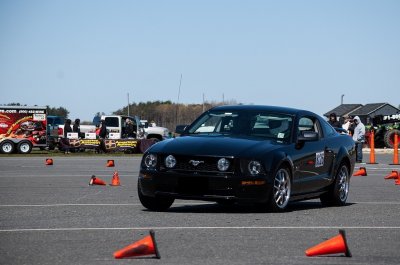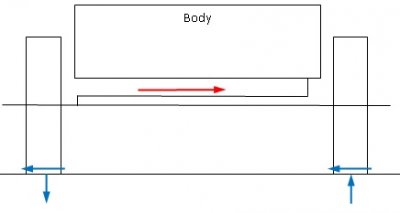Norm Peterson
corner barstool sitter
I get the print magazine, so I haven't really tried to find this stuff online.Is any of that online? If so, where?
Greater lateral load transfer would obviously occur initially at the rear with the higher rear geo RC. Actually, this is a component of understeer/oversteer, just one of several, and its individual effect would be oversteerish. It's a slip angle thing (difference in slip angles, actually), and applicable at any level of lateral acceleration (though obviously more noticeable at the higher lateral g's).Where would the initial oversteer come from?
Unless the car really is a wet noodle, the front and rear will stabilize in roll at the same time.The front roll moment is greater than the rear roll moment. Therefore, at the point where the rear would be stabilized in roll due to the weight transfer in the rear, the front has not stabilized. The additional roll in the front is transferred to the rear via the chassis, which increases the amount of compression force on the outside rear tire while the amount of lateral force there remains the same, and therefore the rear gets greater compression force at the tire and thus greater adhesion. Greater adhesion in the rear than the front gets you understeer.
LLT through the roll centers is fixed, consider it a function only of the sprung mass CG X-axis (longitudinal) location.
LLT through suspension roll stiffnesses is apportioned according to their relative stiffnesses (assuming a decently rigid chassis). With linear-rate springs and bars and motion ratios that don't shift much over suspension deflection, this is also a relatively fixed relationship. Damper behavior kind of messes with this as the roll rotation is actually in progress, but drops out at steady-state (yeah, I know this doesn't ever really occur, but it probably helps here to assume that it can).
I suspect my car does the way it sits (and I had an instructor specifically mention it recently); the M3 with a more level "roll axis" is going to roll like a boat in a beam sea and start out with a better balance between front and rear LLT due to RC heights.The M3 might well behave like that.
You should be able to easily throttle-steer through the middle with only small throttle adjustments or find a throttle setting that holds you on line through turns of 180° or more.What I've noticed from the Mustang's suspension is that if I go into a corner hard enough, I'll get a lot of initial understeer unless I go into it with some trail braking. Once the car is going around the corner, I can control the rear with the throttle. With the stock suspension without camber plates, I was able to make the car "tuck in" by lifting the throttle, but the rear wouldn't come out. With camber plates, I can make the rear come out simply by lifting off the throttle.
So it seems like the car's behavior is basically corner entry understeer (except when trail braking), and mid-corner neutrality (or darned close to it), and corner exit oversteer can be induced if you give it enough throttle on corner exit.
Aside from front tires and wheel widths, tire pressures, and tinkering with the dampers, I'm thinking front control arm bushings (firmer).What changes can be made to the car to make corner entry neutral, but otherwise retain the characteristics it seems to have with camber plates?
Norm





